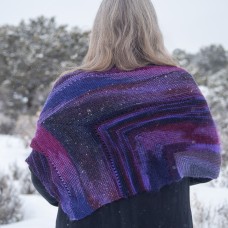| View or download a .pdf of this pattern |
|
Supplies: One Skein Cat Mountain Fiber Arts Fusion 800 Fingering Weight. 3.75 mm/US Size 5 circular needle, 90cm/36inch or longer. Sample Garment knit in Stormy Fusion 800 comes with 100 yards each of 8 different yarns. You may choose to knit the yarns in whatever order you wish, though many people want to know what order I used when knitting the sample. Below are the eight yarns included in the skein, in the order in which they were used in the shawl with brief descriptions to help you identify them. Fusion 800 Yarns & Descriptions: 1) 60% Superwash Merino Wool/30% Bamboo/10%Nylon – Lighter color, soft sheen, crisp texture 2) 80% Kid Mohair/20% Nylon –Fuzzy kid mohair 3) 100% Superwash Merino Wool – Soft, dark in color 4) 85% Superwash Merino Wool/15% NEP – Tweed 50% 5) Merino Wool/50% Silk – Dark in color, sheen, very soft 6) 75 % Superwash Merino Wool/20%Nylon/5%Stellina – Sparkly 7) 86% Kid Mohair/14% Nylon - Soft Boucle 8) 50% Merino Wool/50% Tencel – Lighter color, soft sheen, crisp texture Please note that #1 and #8 look very similar and are difficult to tell apart. For the purposes of this pattern, they are interchangeable. Gauge – Approximately 6 stitches and 12 rows per inch, worked in garter stitch. Please note that if your gauge varies greatly from the above, you may run out of yarn before the end of the shawl. Please see below for a discussion of this shawl construction and ways to ensure you don’t run out of yarn. Kite shaped shawls are constructed in two sections. In the first section, the work is increased symmetrically with yarn overs on each edge on both wrong and right side rows, and a double decrease in the center on right side rows. In the second section, increases on the left edge (left when the right side is facing you) are eliminated, and the the center double decrease will shift to the left of the work, with the shawl being finished when it reaches the left edge. Approximately 40% of the yardage is used for the first section, and 60% for the second. Therefore, if you have used 320 yards of your skein (40% of 800 yards = 320 yards) before the instructions indicate the shift to Section 2, you may run out of yarn before finishing. You may prevent this by changing to the Section 2 instructions when you have used 320 yards even if it is before these instructions say to do so. It is helpful if you have a scale that measure grams for estimating yardage and how much you have left. A trick I used for the sample was leaving approximately 10 yards of Yarn 1 instead of using all of it before switching to Yarn 2. Since Yarns 1 and 8 look very similar, this was an “insurance policy” in case I ran out of Yarn 8 at the end, I would still have enough to finish with a yarn that looked the same. I strongly suggest using this trick! Abbreviations: K – Knit P – Purl YO – Yarn Over S – Slip K2Tog – Knit 2 Together PSSO – Pass Slipped Stitch Over PM – Place Marker SM – Slip Marker Section 1: With Yarn #1, Cast on 3 Stitches Row 1: K1, YO, P1, YO, K1 Row 2: K1, YO, S1, K2Tog, PSSO, YO, K1 Row 3: K1, YO, K1, P1, K1, YO, K1 Row 4: K1, YO, K1, S1, K2Tog, PSSO, PM, K1, YO, K1 Row 5: K1, YO, Knit to the marker, SM, P1, knit to the last stitch, YO, K1 Row 6: K1, YO, knit to 2 stitches before the marker, S1, K2tog, PSSO (you will need to remove and replace the marker to execute this), Knit to the last stitch, YO, K1 Repeat Rows 5 and 6, changing yarns as you run out of each one. When you have a total of 155 Stitches on the needle (77 on the right side of the marker and 78 on the left), change to Section 2 Instructions. You may choose to not use a marker if you are confident that you will see the place where you need to do the double decrease on the right side rows and the center purl stitch on the wrong side rows. Optional eyelet row: This is entirely optional can be added to make things more interesting. On the sample, an eyelet row was added approximately every sixty rows across both Sections 1 and 2. You may choose to do it more or less often, or not at all. If you are like me and knit while binge watching television programs, it may prove annoying to have to count rows to do this, and if you don’t get one at an exact increment, nothing bad will happen. On a Row 6 Repeat: K1, YO, K1, *YO K2Tog*, repeat from * to * until 2 stitches before the Marker, S1, K2Tog, PSSO, repeat from * to * until the last stitch, YO, K1. Row 5 Repeat: Complete as stated in Row 5 instructions. If you get to the center decrease or the left edge and have only one stitch left (i.e. are not able to K2 Tog), simply Knit that stitch. Nothing bad will happen! Section 2: Beginning on the next Row 6 Repeat (Right side facing) Row: Row 1: K1, YO knit to 2 stitches before the marker, S1, K2tog, PSSO (you will need to remove and replace the marker to execute this), Knit to the last stitch, K1. Row 2: K1, Knit to the marker, SM, P1, knit to the last stitch, YO, K1 Note: You are not increasing on the left side of the work any longer. You are still increasing on the right side of the work. The center line where your double decrease occurs will begin shifting to the left of the work, by one stitch every two rows. When you get all the way to the left with it, consuming the last stitch with the double decrease, you are ready to bind off. This will occur on a Row 2 (Section 2) repeat row. Block by soaking in water with a drop of shampoo or wool wash, then roll in a towel and pin out on a flat surface. |
| View or download a .pdf of this pattern |
Let's Go Fly a Kite Pattern
- Product Code: pat-flyakite
- Availability: In Stock
Free Pattern Click Link to Download


